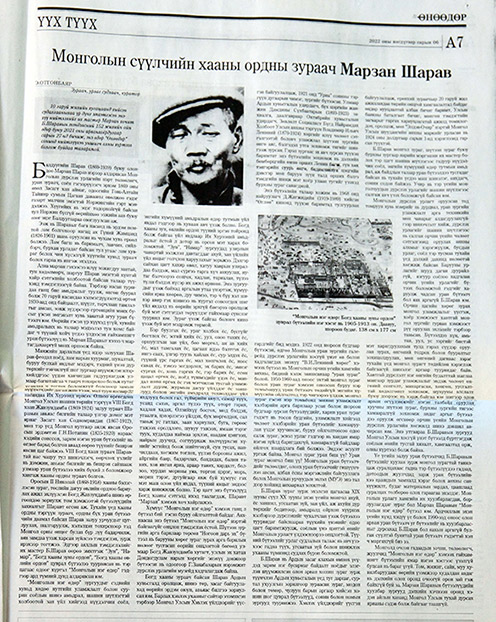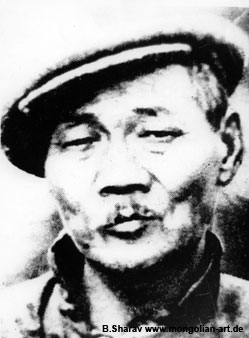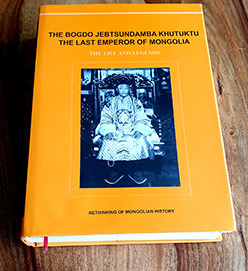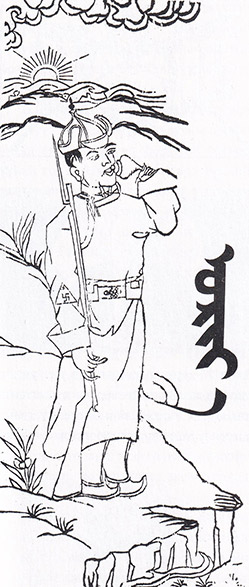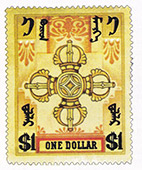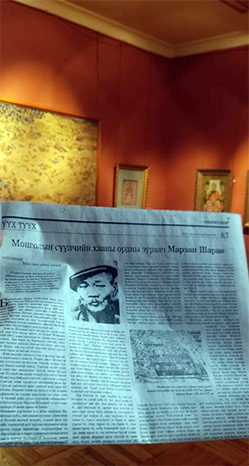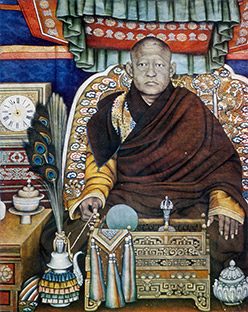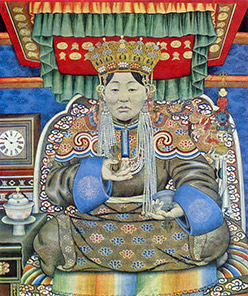(1869-1939)
The Court painter for the last Emperor of Mongolia
-- The original text in Mongolian --
-- Der Text auf Deutsch --
Translated by Ider Batbayar, edited by Ariun Sanjaajamts. Ulaanbaatar, Mongolia 2022
The English translation made public on 17 March 2022 Berlin
OtGO
Otgonbayar Ershuu © 12-27-2021 Berlin, Germany
Sharav Balduu, also known as Marzan
(facetious), was an important cultural figure and a famous artist and
enlightener of Mongolia. He was born in the winter of 1869 as the son
of a herdswoman Norjin in Tsagaan Pass Winter Camp of Gobi-Altai
province, previously called Zasagt Khan province. He was named after
his grandfather Balduu, as his father was unknown.
His mother wanted him to be a well-educated monk, so she apprenticed him to his uncle Jamts Gun (1826-1901), a Buddhist monk. Although Sharav never wanted to become a monk, his training with his uncle was a significant turning point in his life. It paved his way to becoming an artist because his uncle was not only a monk but also a Thangka painter, wax modeler, woodcarver, and sculptor.
In everyday life, Sharav was not particularly humorous but an extraordinarily hardworking and a bit reserved person. He wasn't married, never had a romantic relationship with any woman, and lived his life as a bachelor. This great artist experienced the harshness of the socialist repressions of the 1930s in his 70s and tragically left this world. He had no children, and his private life details are less known to us. However, the remarkable artistic legacy of Marzan Sharav and his contribution to the development of Mongolian art will be preserved through his masterpieces for centuries to come.
When he was younger during the Manchu period, Sharav experienced persecution because of his caricatures of some fraudulent feudal lords and monks. His honor code could not tolerate their deceptive, greedy behavior and true negative nature. Eventually, he could no longer get along well with his teacher. He left his homeland with the migrating nomads, their caravan, and cattle. He arrived in the capital Ikh Khuree at 22.
The eighth Bogdo Khaan Jebtsundamba (1869-1924), the head of state and religious leader of Mongolia, had heard the legendary stories of the talented young artist Sharav from Zasagt-Khan Sodnomravdan (1867-1912), the provincial leader of Zasagt-Khan, and the visiting Russian scholar Grigory Nikolayevich Potanin (1835-1920). "He has drawn miniature representations of gods on his fingernails so that you could not see them well with the naked eye."
Bogdo Khaan Jebtsundamba, in particular, had been an admirer of Sharav's artworks for some time before. He received some of Sharav’s paintings in gifts or offerings, which he integrated into his art collection. A friend and supporter of Sharav, Bogd Khan - the same age - was very fond of his friend's critical position and appreciated his artistic talent. He offered Sharav every opportunity to develop his art further and eventually appointed him Court Painter to Bogdo Khaan.
Bogdo Khaan, who received an architectural design of a winter palace as a gift from the Russian Tsar Nicholas II (1868-1918), immediately began building it and commissioned Sharav to produce large-scale works of art. As the head and manager of the palace artists' group, Sharav gathered a select few young artists. He traveled with some to explore the country and collect experiences to draw and paint. The great master Sharav compiled the pictorial records of these journeys into an extensive group of works and created a series of art pieces among Mongolia’s most important visual documents to this day. The outstanding paintings are "Summer," "Autumn," "Bogdo Khaan's Summer Palace," and "Bogdo Khaan's Winter Palace." These masterpieces have become so popular that the people have since named them “One Day in Mongolia.”
The themes of the cycle "One Day in Mongolia" can be divided into 'The Traditional Country Life,' 'The New Life of the Settled Culture,' 'Religious Rituals,' 'The Nomadic Culture,' and 'Everyday Events of Ordinary Life.' Moreover, Master Sharav's accounts of events around Bogdo Khaan's summer and winter palaces offer a bird's-eye view of many aspects of life in the capital Ikh Khuree. The paintings "Summer" and "Autumn" mainly depict seasonal rituals. During the pleasant warmer months, there is much work for people to do in nature to prepare for the coming seasons of cold winter and severe spring. It includes fattening the cattle, choosing suitable pastures, and stocking up on hay and firewood. Looking at these paintings, one can feel the scent of the steppe, hear the sound of people conversing, and even their whispers, as if you were already attending such events. That makes these works of art remarkably vivid and sensual. It's like watching a movie even though you're only looking at the paintings.
One can see and observe many events and rituals from these paintings. On the one hand, these paintings showcase customs that follow specific traditional practices such as: “The custom of marrying one’s son to the bride,” “The marriage ceremony,” “The custom of carrying out arranged marriage,” “The ritual of felt making,” “The ritual of worshipping mountains and stone cairns,” “Funeral rites,” “Shamanism,” “Hunting ritual,” “Cattle branding ritual,” "Preparation of dairy products,” “Milking camels,” “Fairy tales and oral epic demonstration," "Reception and farewell to the nobles," "Milking the mare," "Castrating cattle," "Preparing wool," "Shearing the camel," "Pregnancy, childbirth and midwifery," "Training young horses," "Slaughtering sheep," "Setting up a ger (traditional Mongolian housing)," "The ritual of offering nine sprinkles," and "Offering Mandala and Shiva," and others.
On the other hand, these paintings feature ordinary life events, including: "fire hazards," "picking pine nuts," "swimming," "collecting animal dung for fuel," "moving to a new pasture," "haymaking," "putting up a scarecrow," "lumbering," "washing and cleaning," "bullfighting," "river crossing on a raft," "herding elephants," "attempting to breed deer and antelopes," "feeding the birds," "pushing a goat cart," "trading," "entertainment," "ceremony singers," "punishing misbehaving drunk person by wrapping him in a felt," "fighting," "playing musical instruments," "lovemaking," "festival of fermented mare’s milk," "traveling monk," "male-to-male intercourse," "bowel movement," "gossiping," "cheating," "jealousy," "going out," "dating," "drinking," "training racehorses," "esteemed guardsmen," and “people on horses, horse-drawn carts, and bicycles,” and so on.
At that time, Bogdo Khaan was very pleased with these artworks and gave him the artist name “Marzan” (facetious). There is a misconception that “One Day in Mongolia” is a single piece of art, and it is necessary to note that this collection of artworks’ original title is not “One Day in Mongolia.”
Painted in the style of thangka painting, "The Green Tara" by Sharav reflects the influence of Western portraiture. Sharav’s portraits of Bogdo Khaan Jebtsundamba and Queen Dondogdulam, created in the same style, are now preserved and exhibited at The Fine Arts Museum of Zanabazar. As the court painter to the Bogdo Khaan, Sharav took part in the people's revolution and devoted his knowledge and talent to establishing a new statehood. With his knowledge and experience of graphic technology and as a printmaker, he helped found the Mongolian State Printing Office in 1921 and designed and decorated the first issue of the newspaper "Uria."
Commissioned by Sukhbaatar Damdin (1893-1923) - the leader of the People's Revolution, the founder of the state, and the supreme commander of the entire army - Sharav painted a portrait of Vladimir Ilyich Lenin (1870-1924) - the leader of the October Revolution and the first head of the Soviet Socialist Republic. He painted these portraits with more freestyle but maintained the traditional style of religious relics and art symbolism. Originally illustrated from a photograph, the conception of this historical work of art evokes the imagery of Thangka in that Teacher Lenin centers in front of the globe with a base color of deep blue sky and a lotus background and the two red flags on his left and right.
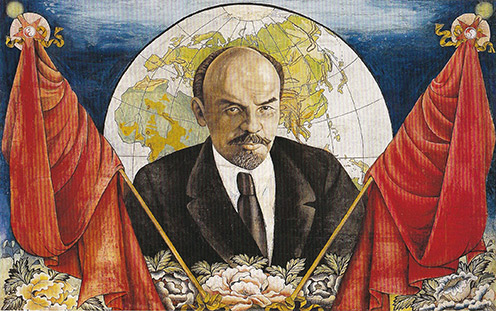
Portrait of Lenin by Marzan Sharav 1922, Tempera on cotton 98 cm x 152 cm
We came to learn that this artwork was later featured in the 1968 historical fact-based film “Ugluu” (Morning) by Jigjid Dejid (1919-1989). This painting entitled Portrait of Lenin, created in 1922 in tempera on cotton and now preserved in The National Art Gallery of Mongolia as a priceless legacy of fine art, is the first representation of modern painting (or "fine art," as we are used to calling it) Mongolia.
The erroneous terms “Mongolian painting” versus “fine arts” that arose in the 1950s and 1960s have taken root not only in the minds of artists but also in the minds of ordinary people. The terms "Mongol Zurag" (Mongolian painting) and "Uran Zurag" (fine art) need to be in liberation from the old misconceptions of referring Mongolian painting to traditional-style works of art created with water and tempera paints while fine art to traditional and free oil painting. It must now be recognized independently of everything as “painting” or “art” without barriers and misunderstandings!
It begs questions. Isn't Mongolian painting a fine art? Isn't the fine art a Mongolian? The Union of Mongolian Artists (UMA), the only formal professional body representing most Mongolian artists through memberships, should pay further attention!
From the beginning, Sharav focused heavily on his artworks to depict as realistically as possible the Mongolian lifestyle, customs, ethnography, rituals, and socio-economic images of the late 19th and early 20th centuries. Such records and preservation of historical evidence for today's generation made his artworks unique and are considered the most priceless tangible cultural heritage of Mongolian art. His works can be not only art-history research but also a study from historical, ethnographic, and scientific perspectives.
Before the victory of the people's revolution, Sharav painted dozens of caricatures mocking and criticizing some indecent feudal lords. Also during the People's Revolution, he created a series of mimicries, cartoons, and illustrations for newspapers and books using the graphic techniques of “intaglio printing,” "woodcut," "linocut," and "engraving" for flags and propaganda. During his more than 20 years as an official artist and co-founder of the Mongolian State Printing Office, he was responsible for the designs of highly secure official classified documents, state bank guarantee certificates, and banknotes, as well as the first Mongolian postage stamp "Eldev-Ochir", released on 1 July 1924.
It was revolutionary, pioneering, and remarkable that Sharav's artworks reflected the nomadic culture and everyday life of ordinary people outside of religion while reaching the level of a great master in thangka painting and traditional Mongolian painting. It was because Mongolian art could not be in separation from religion at that time. So it was very unusual to create art outside of the Buddhist faith because the patrons didn't like it and didn't want to support it.
Sharav's significant contributions to Mongolian fine arts include his commitment to modernizing fine arts without jeopardizing traditional artistic techniques, detaching fine arts from religion while introducing a modern freestyle mind shift. He pioneered and initiated his modern painting style without directly imitating influential and popular Western art while preserving cultural and national identity.
He created the modern Mongolian tradition of portraiture and introduced the transformation of two-dimensional flat-colored Mongolian traditional paintings into three dimensions. He added light and shadow in his paintings and adjusted the brightness and reduction of colors to enliven people, animals, mountains, and water. He used color spectra—novel techniques hardly ever used in Mongolian paintings at the time.
He broke with the tradition of creating paintings with flat colors, meaning no shading or perspective, but emphasizing form and contour in the form of monochromatic patterns. He made progressive contributions to the development of Mongolian fine arts by promoting the free choice of color and introducing dullness and light, soluble animation, and shading. His paintings offer a bird's-eye view as if one could see them from above by incorporating dozens of stories simultaneously into his artworks, free from the traditional style and central lines of religious relic-making. In recognition of Sharav’s contributions, his paintings are among the priceless masterpieces of Mongolia, preserved under special supervision and protection of cultural heritage, and open to the public.
Generation after generation, young artists learn about Mongolian painting by reproducing Sharav's work. In addition, they sell their reproductions to foreign tourists and begin to earn the initial funding to purchase materials such as colors and further pay tuition fees for their studies. Marzan Sharav's the themes of the cycle "One Day in Mongolia" is the most reproduced and best-selling Mongolian art piece. Given the difficult times of the early days of democracy in the 1990s, dozens of artists copied and sold these artworks to earn a living. Sharav was undoubtedly a virtuous, influential, and generous artist.
Foreign visitors to Mongolia do not return home without seeing some parts of the magnificent artwork “One Day in Mongolia.” Perhaps, there is no place left in the world where big or small, good or bad copies of his paintings haven’t reached. No one knows precisely how many copies of Marzan Sharav's works are on the walls of how many homes in how many countries around the world where his artworks inspire conversations about Mongolia.
Author’s note
This article, compiled from the results of more than ten years of research, was written in OTGO’s Art Space Berlin (studio and gallery) on December 27, 2021, on the occasion of the 152nd birthday of the great master of painting Marzan called Sharav. The author thanks the Mongolian daily newspaper "Today" (Unuudur) for publishing this article and making it publicly available on 6 January 2022.
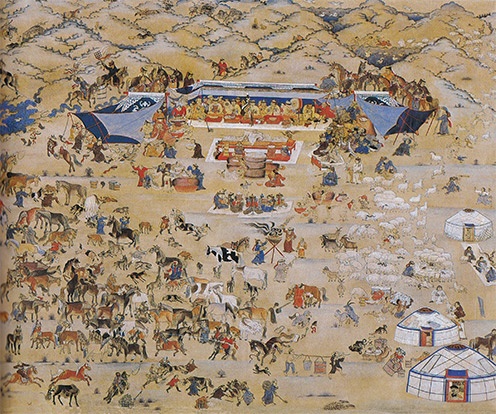
One Day in Mongolia
Summer by Marzan Sharav 1905-1913, Tempera on cotton 138 cm x 177 cm
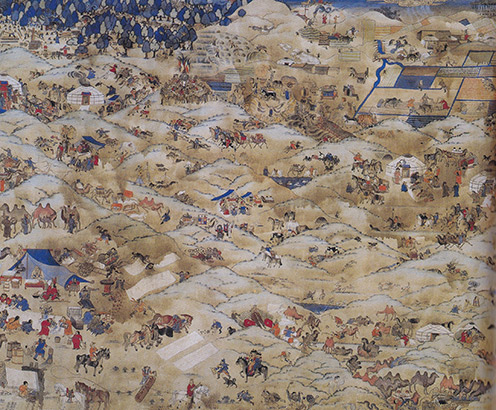
One Day in Mongolia
Autumn by Marzan Sharav 1905-1913, Tempera on cotton 138 cm x 177 cm
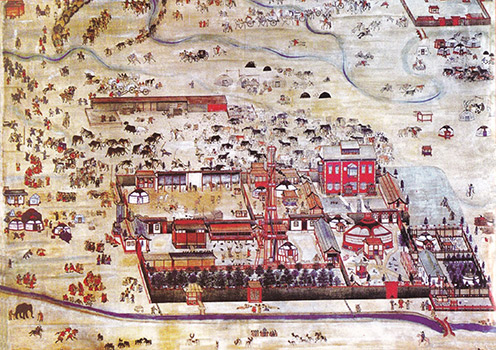
One Day in Mongolia
Bogd Khan's Summer Palace by Marzan Sharav 1905-1913, Tempera on cotton 138 cm x 177 cm
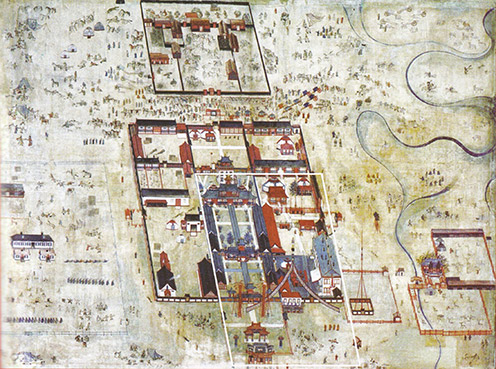
One Day in Mongolia
Bogdo Khaan's Winter Palace by Marzan Sharav 1905-1913, Tempera on cotton 138 cm x 177 cm
His mother wanted him to be a well-educated monk, so she apprenticed him to his uncle Jamts Gun (1826-1901), a Buddhist monk. Although Sharav never wanted to become a monk, his training with his uncle was a significant turning point in his life. It paved his way to becoming an artist because his uncle was not only a monk but also a Thangka painter, wax modeler, woodcarver, and sculptor.
In everyday life, Sharav was not particularly humorous but an extraordinarily hardworking and a bit reserved person. He wasn't married, never had a romantic relationship with any woman, and lived his life as a bachelor. This great artist experienced the harshness of the socialist repressions of the 1930s in his 70s and tragically left this world. He had no children, and his private life details are less known to us. However, the remarkable artistic legacy of Marzan Sharav and his contribution to the development of Mongolian art will be preserved through his masterpieces for centuries to come.
When he was younger during the Manchu period, Sharav experienced persecution because of his caricatures of some fraudulent feudal lords and monks. His honor code could not tolerate their deceptive, greedy behavior and true negative nature. Eventually, he could no longer get along well with his teacher. He left his homeland with the migrating nomads, their caravan, and cattle. He arrived in the capital Ikh Khuree at 22.
The eighth Bogdo Khaan Jebtsundamba (1869-1924), the head of state and religious leader of Mongolia, had heard the legendary stories of the talented young artist Sharav from Zasagt-Khan Sodnomravdan (1867-1912), the provincial leader of Zasagt-Khan, and the visiting Russian scholar Grigory Nikolayevich Potanin (1835-1920). "He has drawn miniature representations of gods on his fingernails so that you could not see them well with the naked eye."
Bogdo Khaan Jebtsundamba, in particular, had been an admirer of Sharav's artworks for some time before. He received some of Sharav’s paintings in gifts or offerings, which he integrated into his art collection. A friend and supporter of Sharav, Bogd Khan - the same age - was very fond of his friend's critical position and appreciated his artistic talent. He offered Sharav every opportunity to develop his art further and eventually appointed him Court Painter to Bogdo Khaan.
Bogdo Khaan, who received an architectural design of a winter palace as a gift from the Russian Tsar Nicholas II (1868-1918), immediately began building it and commissioned Sharav to produce large-scale works of art. As the head and manager of the palace artists' group, Sharav gathered a select few young artists. He traveled with some to explore the country and collect experiences to draw and paint. The great master Sharav compiled the pictorial records of these journeys into an extensive group of works and created a series of art pieces among Mongolia’s most important visual documents to this day. The outstanding paintings are "Summer," "Autumn," "Bogdo Khaan's Summer Palace," and "Bogdo Khaan's Winter Palace." These masterpieces have become so popular that the people have since named them “One Day in Mongolia.”
The themes of the cycle "One Day in Mongolia" can be divided into 'The Traditional Country Life,' 'The New Life of the Settled Culture,' 'Religious Rituals,' 'The Nomadic Culture,' and 'Everyday Events of Ordinary Life.' Moreover, Master Sharav's accounts of events around Bogdo Khaan's summer and winter palaces offer a bird's-eye view of many aspects of life in the capital Ikh Khuree. The paintings "Summer" and "Autumn" mainly depict seasonal rituals. During the pleasant warmer months, there is much work for people to do in nature to prepare for the coming seasons of cold winter and severe spring. It includes fattening the cattle, choosing suitable pastures, and stocking up on hay and firewood. Looking at these paintings, one can feel the scent of the steppe, hear the sound of people conversing, and even their whispers, as if you were already attending such events. That makes these works of art remarkably vivid and sensual. It's like watching a movie even though you're only looking at the paintings.
One can see and observe many events and rituals from these paintings. On the one hand, these paintings showcase customs that follow specific traditional practices such as: “The custom of marrying one’s son to the bride,” “The marriage ceremony,” “The custom of carrying out arranged marriage,” “The ritual of felt making,” “The ritual of worshipping mountains and stone cairns,” “Funeral rites,” “Shamanism,” “Hunting ritual,” “Cattle branding ritual,” "Preparation of dairy products,” “Milking camels,” “Fairy tales and oral epic demonstration," "Reception and farewell to the nobles," "Milking the mare," "Castrating cattle," "Preparing wool," "Shearing the camel," "Pregnancy, childbirth and midwifery," "Training young horses," "Slaughtering sheep," "Setting up a ger (traditional Mongolian housing)," "The ritual of offering nine sprinkles," and "Offering Mandala and Shiva," and others.
On the other hand, these paintings feature ordinary life events, including: "fire hazards," "picking pine nuts," "swimming," "collecting animal dung for fuel," "moving to a new pasture," "haymaking," "putting up a scarecrow," "lumbering," "washing and cleaning," "bullfighting," "river crossing on a raft," "herding elephants," "attempting to breed deer and antelopes," "feeding the birds," "pushing a goat cart," "trading," "entertainment," "ceremony singers," "punishing misbehaving drunk person by wrapping him in a felt," "fighting," "playing musical instruments," "lovemaking," "festival of fermented mare’s milk," "traveling monk," "male-to-male intercourse," "bowel movement," "gossiping," "cheating," "jealousy," "going out," "dating," "drinking," "training racehorses," "esteemed guardsmen," and “people on horses, horse-drawn carts, and bicycles,” and so on.
At that time, Bogdo Khaan was very pleased with these artworks and gave him the artist name “Marzan” (facetious). There is a misconception that “One Day in Mongolia” is a single piece of art, and it is necessary to note that this collection of artworks’ original title is not “One Day in Mongolia.”
Painted in the style of thangka painting, "The Green Tara" by Sharav reflects the influence of Western portraiture. Sharav’s portraits of Bogdo Khaan Jebtsundamba and Queen Dondogdulam, created in the same style, are now preserved and exhibited at The Fine Arts Museum of Zanabazar. As the court painter to the Bogdo Khaan, Sharav took part in the people's revolution and devoted his knowledge and talent to establishing a new statehood. With his knowledge and experience of graphic technology and as a printmaker, he helped found the Mongolian State Printing Office in 1921 and designed and decorated the first issue of the newspaper "Uria."
Commissioned by Sukhbaatar Damdin (1893-1923) - the leader of the People's Revolution, the founder of the state, and the supreme commander of the entire army - Sharav painted a portrait of Vladimir Ilyich Lenin (1870-1924) - the leader of the October Revolution and the first head of the Soviet Socialist Republic. He painted these portraits with more freestyle but maintained the traditional style of religious relics and art symbolism. Originally illustrated from a photograph, the conception of this historical work of art evokes the imagery of Thangka in that Teacher Lenin centers in front of the globe with a base color of deep blue sky and a lotus background and the two red flags on his left and right.

Portrait of Lenin by Marzan Sharav 1922, Tempera on cotton 98 cm x 152 cm
We came to learn that this artwork was later featured in the 1968 historical fact-based film “Ugluu” (Morning) by Jigjid Dejid (1919-1989). This painting entitled Portrait of Lenin, created in 1922 in tempera on cotton and now preserved in The National Art Gallery of Mongolia as a priceless legacy of fine art, is the first representation of modern painting (or "fine art," as we are used to calling it) Mongolia.
The erroneous terms “Mongolian painting” versus “fine arts” that arose in the 1950s and 1960s have taken root not only in the minds of artists but also in the minds of ordinary people. The terms "Mongol Zurag" (Mongolian painting) and "Uran Zurag" (fine art) need to be in liberation from the old misconceptions of referring Mongolian painting to traditional-style works of art created with water and tempera paints while fine art to traditional and free oil painting. It must now be recognized independently of everything as “painting” or “art” without barriers and misunderstandings!
It begs questions. Isn't Mongolian painting a fine art? Isn't the fine art a Mongolian? The Union of Mongolian Artists (UMA), the only formal professional body representing most Mongolian artists through memberships, should pay further attention!
From the beginning, Sharav focused heavily on his artworks to depict as realistically as possible the Mongolian lifestyle, customs, ethnography, rituals, and socio-economic images of the late 19th and early 20th centuries. Such records and preservation of historical evidence for today's generation made his artworks unique and are considered the most priceless tangible cultural heritage of Mongolian art. His works can be not only art-history research but also a study from historical, ethnographic, and scientific perspectives.
Before the victory of the people's revolution, Sharav painted dozens of caricatures mocking and criticizing some indecent feudal lords. Also during the People's Revolution, he created a series of mimicries, cartoons, and illustrations for newspapers and books using the graphic techniques of “intaglio printing,” "woodcut," "linocut," and "engraving" for flags and propaganda. During his more than 20 years as an official artist and co-founder of the Mongolian State Printing Office, he was responsible for the designs of highly secure official classified documents, state bank guarantee certificates, and banknotes, as well as the first Mongolian postage stamp "Eldev-Ochir", released on 1 July 1924.
It was revolutionary, pioneering, and remarkable that Sharav's artworks reflected the nomadic culture and everyday life of ordinary people outside of religion while reaching the level of a great master in thangka painting and traditional Mongolian painting. It was because Mongolian art could not be in separation from religion at that time. So it was very unusual to create art outside of the Buddhist faith because the patrons didn't like it and didn't want to support it.
Sharav's significant contributions to Mongolian fine arts include his commitment to modernizing fine arts without jeopardizing traditional artistic techniques, detaching fine arts from religion while introducing a modern freestyle mind shift. He pioneered and initiated his modern painting style without directly imitating influential and popular Western art while preserving cultural and national identity.
He created the modern Mongolian tradition of portraiture and introduced the transformation of two-dimensional flat-colored Mongolian traditional paintings into three dimensions. He added light and shadow in his paintings and adjusted the brightness and reduction of colors to enliven people, animals, mountains, and water. He used color spectra—novel techniques hardly ever used in Mongolian paintings at the time.
He broke with the tradition of creating paintings with flat colors, meaning no shading or perspective, but emphasizing form and contour in the form of monochromatic patterns. He made progressive contributions to the development of Mongolian fine arts by promoting the free choice of color and introducing dullness and light, soluble animation, and shading. His paintings offer a bird's-eye view as if one could see them from above by incorporating dozens of stories simultaneously into his artworks, free from the traditional style and central lines of religious relic-making. In recognition of Sharav’s contributions, his paintings are among the priceless masterpieces of Mongolia, preserved under special supervision and protection of cultural heritage, and open to the public.
Generation after generation, young artists learn about Mongolian painting by reproducing Sharav's work. In addition, they sell their reproductions to foreign tourists and begin to earn the initial funding to purchase materials such as colors and further pay tuition fees for their studies. Marzan Sharav's the themes of the cycle "One Day in Mongolia" is the most reproduced and best-selling Mongolian art piece. Given the difficult times of the early days of democracy in the 1990s, dozens of artists copied and sold these artworks to earn a living. Sharav was undoubtedly a virtuous, influential, and generous artist.
Foreign visitors to Mongolia do not return home without seeing some parts of the magnificent artwork “One Day in Mongolia.” Perhaps, there is no place left in the world where big or small, good or bad copies of his paintings haven’t reached. No one knows precisely how many copies of Marzan Sharav's works are on the walls of how many homes in how many countries around the world where his artworks inspire conversations about Mongolia.
Author’s note
This article, compiled from the results of more than ten years of research, was written in OTGO’s Art Space Berlin (studio and gallery) on December 27, 2021, on the occasion of the 152nd birthday of the great master of painting Marzan called Sharav. The author thanks the Mongolian daily newspaper "Today" (Unuudur) for publishing this article and making it publicly available on 6 January 2022.
Зохиогчийн зөвшөөрөлгүй
хувилан олшруулах, хэсэгчлэн болон бүхлээр нь нийтлэхийг хориглоно.
Зохиогчийн эрх баталгаажсан. © 2021-2022 ОТГО Э.Отгонбаяр www.mongolian-art.de
Зохиогчийн эрх баталгаажсан. © 2021-2022 ОТГО Э.Отгонбаяр www.mongolian-art.de

One Day in Mongolia
Summer by Marzan Sharav 1905-1913, Tempera on cotton 138 cm x 177 cm

One Day in Mongolia
Autumn by Marzan Sharav 1905-1913, Tempera on cotton 138 cm x 177 cm

One Day in Mongolia
Bogd Khan's Summer Palace by Marzan Sharav 1905-1913, Tempera on cotton 138 cm x 177 cm

One Day in Mongolia
Bogdo Khaan's Winter Palace by Marzan Sharav 1905-1913, Tempera on cotton 138 cm x 177 cm
